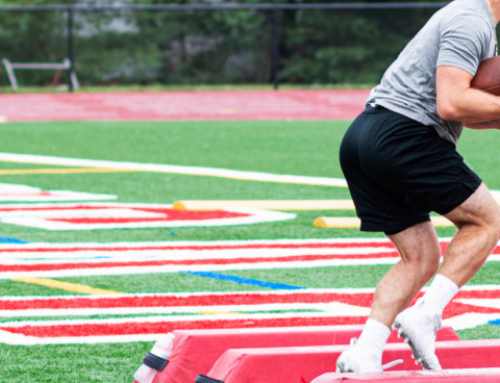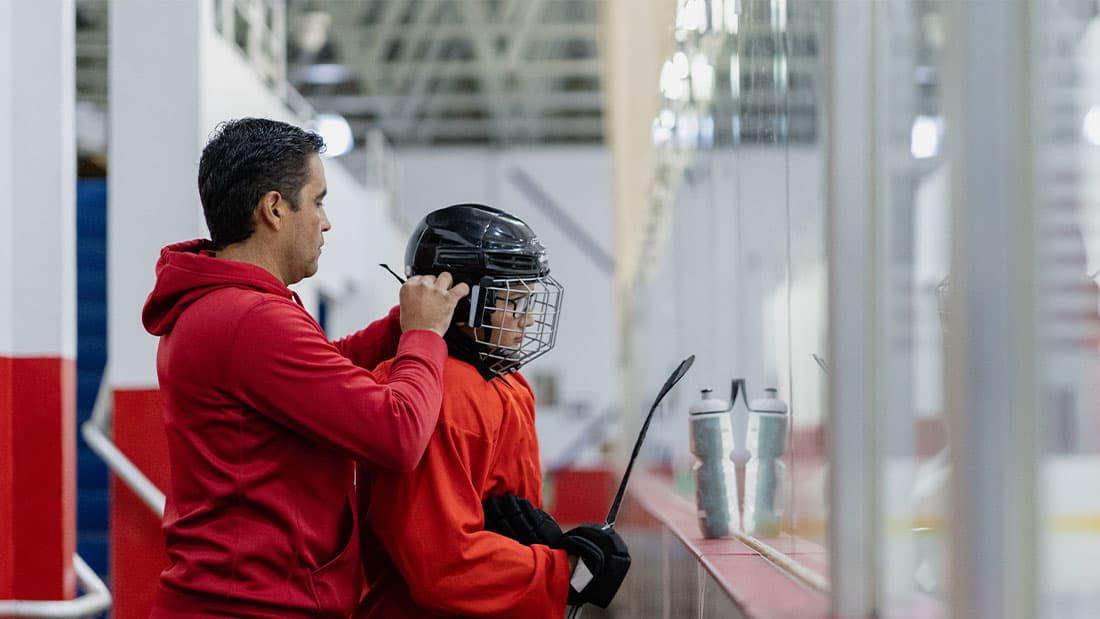Jump and Shred: Jump Rope Workouts for Conditioning and Strength
Do you want a simple, low-cost tool that will improve your conditioning, stamina, footwork and full-body muscular endurance? Get a jump rope. Accomplish new levels of fitness with jump rope workouts that challenge you in a fun, time-efficient way.
The type of jump rope you use can be personal preference, but beaded ropes are good to start with. Speed ropes with ball bearings in the handles allow for smooth rotation and are great for more advanced footwork. Any type of weighted rope will challenge your cardiovascular system and upper body even more, but the weight should be in the rope, not the handles.
To determine the proper length of your jump rope, step on the middle with one foot and bring the handles up along your sides. The tops of the handles should come to your armpits.
RELATED: Five Reasons to Go Back to Basics With the Jump Rope
Determine your current fitness level with the test below.
Jump Rope Fitness Test
Reps: 150 forward / 150 backward for time
You get a total of four minutes to complete the test. This is a running clock, so if you miss, just keep going until you complete 300 reps. Each foot contact with the floor counts as a rep. It can be one foot at a time or both at the same time.
- Stability level – Under 4:00
- Strength level – Under 3:00
- Power Level – Under 1:45
- Pro Level: 100 Double-Unders (50 forward, 50 backwards) – under 2:30
Three different foot positions (two feet together, alternating feet and split stance) can vary the difficulty and challenge you in ways that mimic sport stances on the field. The jump rope workouts below will improve the conditioning of athletes at all levels. Use the workouts as a guide. Work on different skills on different days, but stick to the sets and volume prescribed. Once you have the three stances down, mix them up in the time indicated for levels beyond stability, which will be determined in the test.
RELATED: How to Jump Rope for Football Speed
Workout 1
This plan prescribes different recovery times to accommodate different fitness levels and to allow practicing advanced footwork and rope patterns. If you’re starting a jump rope routine for the first time, or if you’ve gone a few months without plyometric training, start with the Stability level. After four or five weeks, when you’re completing the program, re-test and compare it to your previous time.
Stability: 1:2 Work to Rest Ratio
Jump for 30 seconds and rest for one minute. Practicing different footwork and jumping rope backwards will improve your coordination. When the central nervous system gets involved with a new skill, it can get fatigued. To avoid getting frustrated, allow proper time for rest.
| Sets x Work:Rest | Day 1 | Day 2 | Day 3 | |
| Week 1 | 4 x 30:60 | 2 feet forward | 2 feet backward | Split stance forward |
| Week 2 | 5 x 30:60 | 2 feet forward | 2 feet backward | Split stance forward |
| Week 3 | 6 x 30:60 | 2 feet forward | 2 feet backward | Split stance backward |
| Week 4 | 7 x 30:60 | 2 feet backward | Alternate feet forward | Split stance backward |
| Week 5 | 8 x 30:60 | Alternate feet forward/backward 4 sets each direction |
Split stance forward/backward 4 sets each | Alternate feet forward/backward 4 sets each |
Stability: Progressive Overload
For this program, coordination should be down, but you should be getting faster. Each week add 30 seconds to the workload—up to two minutes at the 4-week mark. Take one day of rest between workouts. While doing two feet, add side-to-side (skiers), and front-to-back (bells) movements.
| Sets x Work:Rest | Day 1 | Day 2 | Day 3 | |
| Week 1 | 4 x 30:60 | 2 feet forward | 2 feet backward | 2 feet foward- skier 2 sets/bell 2 sets |
| Week 2 | 4 x 60:90 | 2 feet- 2 sets forward/2 sets backward | 2 feet forward- skier 2 sets/bell 2 sets | Split stance forward |
| Week 3 | 4 x 90:120 | Alternate feet forward | 2 feet backward | 2 feet forward |
| Week 4 | 4 x 120:180 | Alternate feet forward | 2 feet backward | Alternate feet forward |
Strength 1:1 Work to Rest Ratio
This timed workout gradually increases the work and equal rest from week to week. Do this three days a week with one day of rest between workouts. This is more advanced in footwork and has increased conditioning since the total time is increased and there is less rest.
| Sets x Work:Rest | Day 1 | Day 2 | Day 3 | |
| Week 1 | 4 x 30:30 | Split stance forward | Split stance backward | Double unders forward |
| Week 2 | 5 x 60:60 | 2 feet forward | 2 feet backward | Split stance forward |
| Week 3 | 6 x 90:90 | Alternate feet forward | 2 feet backward | Alternate feet backward |
| Week 4 | 7 x 90:90 | Alternate feet forward | 2 feet backward | Alternate feet backward |
| Week 5 | 8 x 90:90 | Alternate feet forward/backward 4 sets each direction |
Split stance forward/backward 4 sets each | Double unders forward |
Strength: Progressive Overload
This is similar to the Stability level, but it has a greater conditioning component. By week five, the total time of jumping rope is three minutes with only one minute of rest. Since recovery time is shorter, this will improve your cardiovascular system quickly, but you have to mentally push through to the last second every set.
| Sets x Work:Rest | Day 1 | Day 2 | Day 3 | |
| Week 1 | 4 x 1:00:1:00 | 2 feet forward | 2 feet backward | 2 feet forward |
| Week 2 | 4 x 1:30:1:00 | Split stance forward | 2 feet backward | 2 feet forward |
| Week 3 | 4 x 2:00:1:00 | Alternate feet forward | 2 feet backward | Split stance backward |
| Week 4 | 4 x 2:30:1:00 | Alternate feet backward | 2 feet backward | Alternate feet forward |
| Week 5 | 4 x 3:00:1:00 | Alternate feet both directions | Split stance both directions | Split stance both directions |
Power 4×4 Minutes
For this more advanced workout, you jump rope for four continuous minutes with 90 seconds of rest. Change your footwork every 30 seconds. Then alternate forward and backward rope rotation for every set.
Choose from the following:
- Two feet
- Two feet bells (front/back)
- Two feet skiers (side-to-side)
- Alternate feet (running form)
- Split stance
- Two hops right foot, two hops left foot
- Cross arms
- Double unders
Workout 2
This is a circuit of three exercises with two minutes of jumping rope between sets prior to resting. Perform each strength exercise for 30 seconds. Move from one exercise to the next with little or no rest. Do four to six sets.
- Push-Up (30 seconds): Place hands slightly wider than shoulder-width apart with your legs straight. Keep your head in line with your shoulders as you go down and up.
- Front Squat (30 seconds): Use kettlebells in the racked position (resting between your forearms and biceps). To keep the kettlebells from rolling forward off your arms, keep your hands close together and your elbows slightly elevated. Squat down, driving through your heels, then stand up until your hips and knees are completely straight.
- Body Row (30 seconds): Using a bar, suspension system or rings, position your body so your arms are 90 degrees under the handles. Keep your feet flat and your knees bent. Pull your body to the handles using your back and biceps until your chest touches your hands. To make the movement harder, elevate your feet 6-12 inches. Make sure your hips are not higher than your shoulders when you start to pull.
- Jump Rope (2 minutes): Use any combination of stances. This is not the time to work on weak footwork but to perfect and tighten ones you have down. Alternate forward and backward each set. For example, set one forward, set two backward, etc.
- Rest 90 seconds.
RELATED: SURVIVING SEALFIT: The Only 5 Training Tools You Really Need
[cf]skyword_tracking_tag[/cf]RECOMMENDED FOR YOU
MOST POPULAR
Jump and Shred: Jump Rope Workouts for Conditioning and Strength
Do you want a simple, low-cost tool that will improve your conditioning, stamina, footwork and full-body muscular endurance? Get a jump rope. Accomplish new levels of fitness with jump rope workouts that challenge you in a fun, time-efficient way.
The type of jump rope you use can be personal preference, but beaded ropes are good to start with. Speed ropes with ball bearings in the handles allow for smooth rotation and are great for more advanced footwork. Any type of weighted rope will challenge your cardiovascular system and upper body even more, but the weight should be in the rope, not the handles.
To determine the proper length of your jump rope, step on the middle with one foot and bring the handles up along your sides. The tops of the handles should come to your armpits.
RELATED: Five Reasons to Go Back to Basics With the Jump Rope
Determine your current fitness level with the test below.
Jump Rope Fitness Test
Reps: 150 forward / 150 backward for time
You get a total of four minutes to complete the test. This is a running clock, so if you miss, just keep going until you complete 300 reps. Each foot contact with the floor counts as a rep. It can be one foot at a time or both at the same time.
- Stability level – Under 4:00
- Strength level – Under 3:00
- Power Level – Under 1:45
- Pro Level: 100 Double-Unders (50 forward, 50 backwards) – under 2:30
Three different foot positions (two feet together, alternating feet and split stance) can vary the difficulty and challenge you in ways that mimic sport stances on the field. The jump rope workouts below will improve the conditioning of athletes at all levels. Use the workouts as a guide. Work on different skills on different days, but stick to the sets and volume prescribed. Once you have the three stances down, mix them up in the time indicated for levels beyond stability, which will be determined in the test.
RELATED: How to Jump Rope for Football Speed
Workout 1
This plan prescribes different recovery times to accommodate different fitness levels and to allow practicing advanced footwork and rope patterns. If you’re starting a jump rope routine for the first time, or if you’ve gone a few months without plyometric training, start with the Stability level. After four or five weeks, when you’re completing the program, re-test and compare it to your previous time.
Stability: 1:2 Work to Rest Ratio
Jump for 30 seconds and rest for one minute. Practicing different footwork and jumping rope backwards will improve your coordination. When the central nervous system gets involved with a new skill, it can get fatigued. To avoid getting frustrated, allow proper time for rest.
| Sets x Work:Rest | Day 1 | Day 2 | Day 3 | |
| Week 1 | 4 x 30:60 | 2 feet forward | 2 feet backward | Split stance forward |
| Week 2 | 5 x 30:60 | 2 feet forward | 2 feet backward | Split stance forward |
| Week 3 | 6 x 30:60 | 2 feet forward | 2 feet backward | Split stance backward |
| Week 4 | 7 x 30:60 | 2 feet backward | Alternate feet forward | Split stance backward |
| Week 5 | 8 x 30:60 | Alternate feet forward/backward 4 sets each direction |
Split stance forward/backward 4 sets each | Alternate feet forward/backward 4 sets each |
Stability: Progressive Overload
For this program, coordination should be down, but you should be getting faster. Each week add 30 seconds to the workload—up to two minutes at the 4-week mark. Take one day of rest between workouts. While doing two feet, add side-to-side (skiers), and front-to-back (bells) movements.
| Sets x Work:Rest | Day 1 | Day 2 | Day 3 | |
| Week 1 | 4 x 30:60 | 2 feet forward | 2 feet backward | 2 feet foward- skier 2 sets/bell 2 sets |
| Week 2 | 4 x 60:90 | 2 feet- 2 sets forward/2 sets backward | 2 feet forward- skier 2 sets/bell 2 sets | Split stance forward |
| Week 3 | 4 x 90:120 | Alternate feet forward | 2 feet backward | 2 feet forward |
| Week 4 | 4 x 120:180 | Alternate feet forward | 2 feet backward | Alternate feet forward |
Strength 1:1 Work to Rest Ratio
This timed workout gradually increases the work and equal rest from week to week. Do this three days a week with one day of rest between workouts. This is more advanced in footwork and has increased conditioning since the total time is increased and there is less rest.
| Sets x Work:Rest | Day 1 | Day 2 | Day 3 | |
| Week 1 | 4 x 30:30 | Split stance forward | Split stance backward | Double unders forward |
| Week 2 | 5 x 60:60 | 2 feet forward | 2 feet backward | Split stance forward |
| Week 3 | 6 x 90:90 | Alternate feet forward | 2 feet backward | Alternate feet backward |
| Week 4 | 7 x 90:90 | Alternate feet forward | 2 feet backward | Alternate feet backward |
| Week 5 | 8 x 90:90 | Alternate feet forward/backward 4 sets each direction |
Split stance forward/backward 4 sets each | Double unders forward |
Strength: Progressive Overload
This is similar to the Stability level, but it has a greater conditioning component. By week five, the total time of jumping rope is three minutes with only one minute of rest. Since recovery time is shorter, this will improve your cardiovascular system quickly, but you have to mentally push through to the last second every set.
| Sets x Work:Rest | Day 1 | Day 2 | Day 3 | |
| Week 1 | 4 x 1:00:1:00 | 2 feet forward | 2 feet backward | 2 feet forward |
| Week 2 | 4 x 1:30:1:00 | Split stance forward | 2 feet backward | 2 feet forward |
| Week 3 | 4 x 2:00:1:00 | Alternate feet forward | 2 feet backward | Split stance backward |
| Week 4 | 4 x 2:30:1:00 | Alternate feet backward | 2 feet backward | Alternate feet forward |
| Week 5 | 4 x 3:00:1:00 | Alternate feet both directions | Split stance both directions | Split stance both directions |
Power 4×4 Minutes
For this more advanced workout, you jump rope for four continuous minutes with 90 seconds of rest. Change your footwork every 30 seconds. Then alternate forward and backward rope rotation for every set.
Choose from the following:
- Two feet
- Two feet bells (front/back)
- Two feet skiers (side-to-side)
- Alternate feet (running form)
- Split stance
- Two hops right foot, two hops left foot
- Cross arms
- Double unders
Workout 2
This is a circuit of three exercises with two minutes of jumping rope between sets prior to resting. Perform each strength exercise for 30 seconds. Move from one exercise to the next with little or no rest. Do four to six sets.
- Push-Up (30 seconds): Place hands slightly wider than shoulder-width apart with your legs straight. Keep your head in line with your shoulders as you go down and up.
- Front Squat (30 seconds): Use kettlebells in the racked position (resting between your forearms and biceps). To keep the kettlebells from rolling forward off your arms, keep your hands close together and your elbows slightly elevated. Squat down, driving through your heels, then stand up until your hips and knees are completely straight.
- Body Row (30 seconds): Using a bar, suspension system or rings, position your body so your arms are 90 degrees under the handles. Keep your feet flat and your knees bent. Pull your body to the handles using your back and biceps until your chest touches your hands. To make the movement harder, elevate your feet 6-12 inches. Make sure your hips are not higher than your shoulders when you start to pull.
- Jump Rope (2 minutes): Use any combination of stances. This is not the time to work on weak footwork but to perfect and tighten ones you have down. Alternate forward and backward each set. For example, set one forward, set two backward, etc.
- Rest 90 seconds.
RELATED: SURVIVING SEALFIT: The Only 5 Training Tools You Really Need










